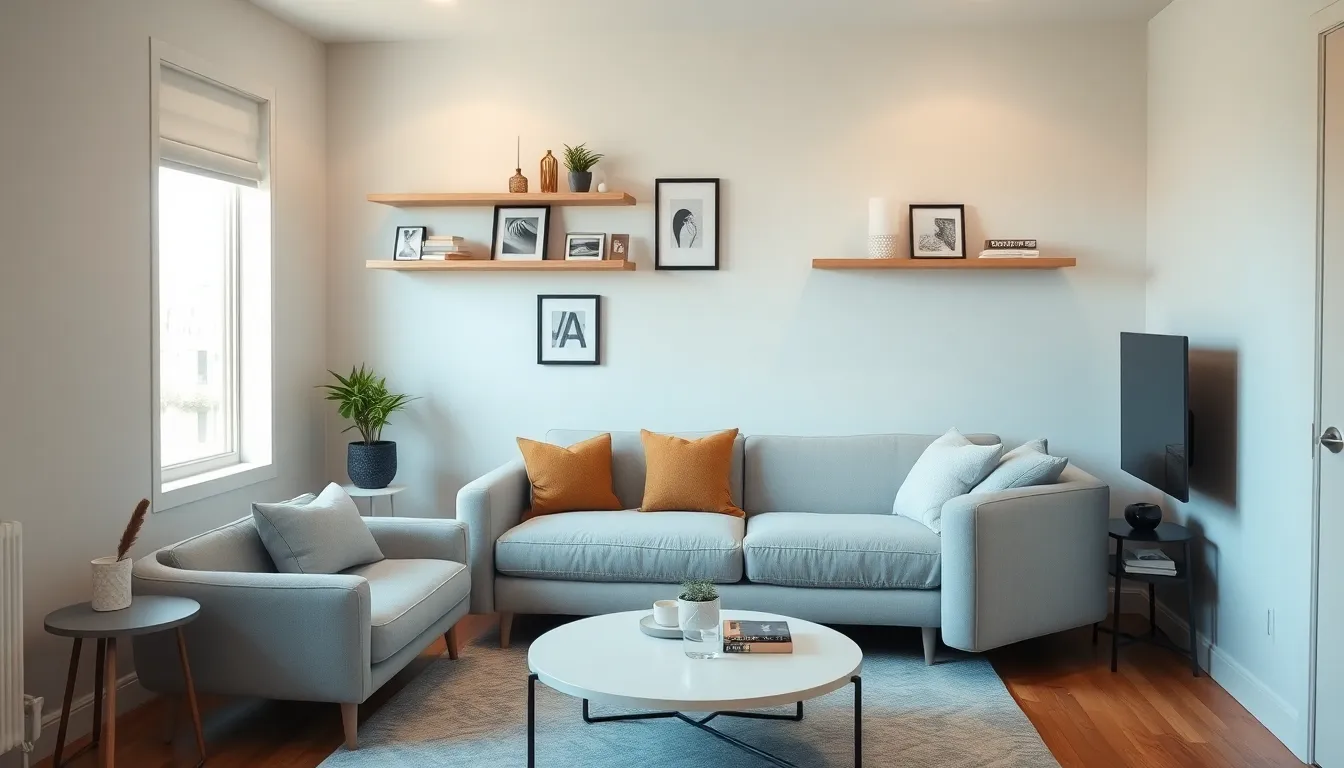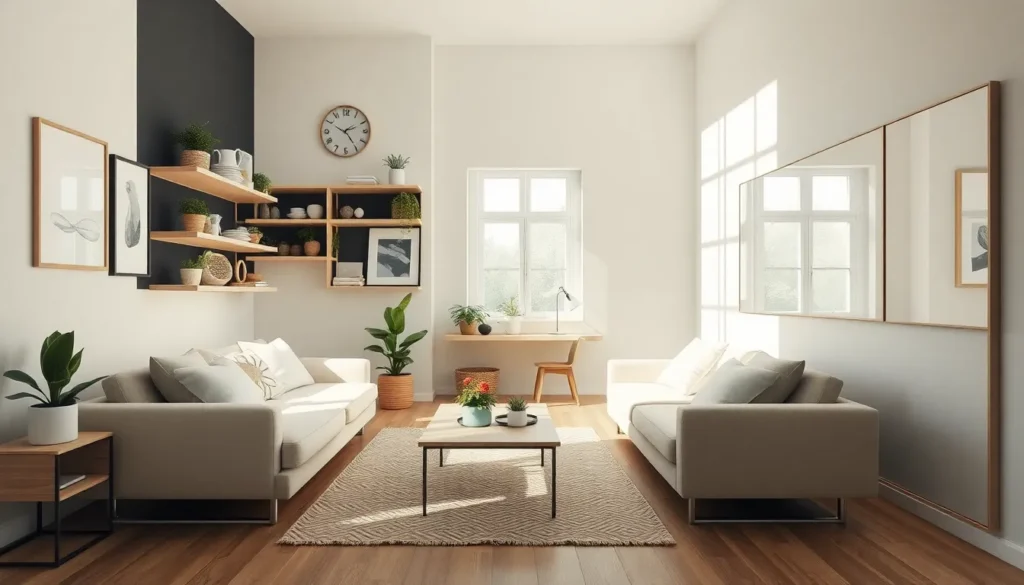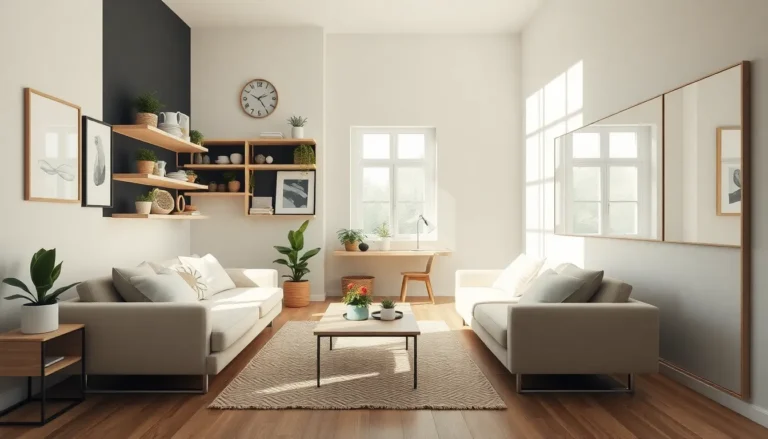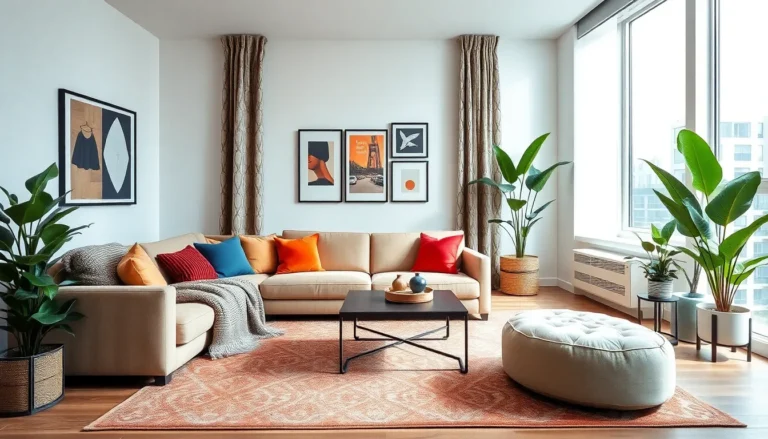Table of Contents
ToggleDesigning a small home can feel like trying to fit a giraffe in a phone booth, possible but definitely challenging. If they think big homes are the only ones that can be stylish, they are in for a surprise. Packed with creativity and smart choices, small spaces can shine just as brightly as mansions. Let’s jump into some clever small home interior design ideas that will have guests swooning, and might just elicit a few jealous gasps.
Understanding Small Space Challenges

When it comes to small spaces, challenges abound. Layout limitations can leave one feeling constrained. Finding storage solutions often resembles a scavenger hunt. Meanwhile, ensuring comfort while maintaining aesthetics becomes an exercise in balance. Small homes may well be called cozy, but they can also seem cramped. Understanding these challenges is the first step toward overcoming them. It’s essential to recognize that smart design can turn limitations into opportunities. By focusing on the essentials, one can create functional yet inviting living spaces.
Recognizing the specific needs of a small home is crucial. Does one frequently entertain? Or perhaps they need a quiet sanctuary for relaxation? Tailoring design choices to function aligns closely with the space’s purpose, and creates a seamless flow within the home.
Maximizing Functionality in Small Areas
To maximize functionality, small areas must be treated like prime real estate. This involves strategic planning. Multifunctional furniture often reigns supreme, offering versatility where space is limited. For instance, a sofa bed can double as a guest bed, saving precious square footage. Conversely, nesting tables offer the option for expandable surfaces when needed, fitting snugly together when not in use.
Another effective approach includes using vertical space. Installing shelves high on walls draws the eye upward, creating an illusion of height. Utilizing under-bed storage can turn the area into a treasure trove of hidden compartments. The key is to think outside the box and employ every nook and cranny.
Small kitchen areas can benefit from open shelves to display chic dishware, making the space feel more expansive while serving its practical purpose. Thoughtful design choices push functionality to the forefront and make daily life more manageable.
Color Schemes for Small Homes
Color schemes can transform a cramped space into a cozy retreat. Light colors often make an area feel larger and airier. Soft whites, pale grays, or muted pastel tones reflect light and create an inviting ambience. But, that doesn’t mean they should be dull. A pop of bold color in a feature wall or accessory can add character without overwhelming the senses.
Also, a monochromatic scheme can provide a sophisticated and cohesive look. Layering various shades of the same color adds depth and interest without cluttering the visual space. For those who possess a bit of adventurous spirit, dark colors can also provide a dramatic effect, making the space feel luxurious when balanced with adequate lighting.
Using color wisely in small homes offers a playful way to craft personality. This means accessorizing with cushions, throws, and art pieces that reflect individual style while keeping the core palette light and spacious.
Smart Furniture Choices for Small Spaces
When shopping for furniture, opting for smart choices is vital. Selecting pieces that serve multiple purposes helps avoid clutter. A coffee table with built-in storage can be a game changer. It’s not just furniture: it’s also functional storage. Folding chairs can be stowed away when not in use, keeping walkways clear.
Choosing furniture with slim profiles helps prevent overwhelming a space. Designs with legs, like sofas and chairs, create visual airiness, allowing floor space to remain visible. It’s all about maintaining balance. Maintain lines of sight by steering clear of bulky pieces.
And let’s not forget about scale. Oversized furniture can dwarf a small room, making it uncomfortable. Stick to appropriately sized items to keep the proportions in check. Smart furniture choices lay the foundation for an elegantly designed small home.
Decorative Elements and Accessories
Decorative elements tie the space together, providing personality. Accessories like art, plants, and textiles breathe life into a small home. Greenery, for instance, adds freshness. Compact houseplants can sit atop shelves or on windowsills, drawing the eye and boosting air quality.
Art pieces can create visual interest without taking up space. Opt for large-scale artwork to make a bold statement on an accent wall, which can trick the eye into thinking the area is larger. Or fine-tune the vibes with a gallery wall that showcases personal tastes while sparking conversation.
Textiles play an important role too: from area rugs to curtains, they inject charm. Layering textures can add warmth and depth, creating inviting layers that beckon relaxation.
Creating Illusions of Space
Illusions of space can be masterfully crafted through clever design. Mirrors, they say, are a designer’s best friend. Strategically placed, they reflect light and create an illusion of depth, making a small room feel more expansive. A large mirror on a wall can often feel like an entire extra window.
Also, using transparent materials, like glass tables or acrylic chairs, can open up visual pathways. Fogged glass can also provide separation while allowing light to flow freely between areas, enhancing openness.
Finally, painting the ceiling a lighter color than the walls can trick the eye into believing the room is taller. These little adjustments can make a world of difference.







